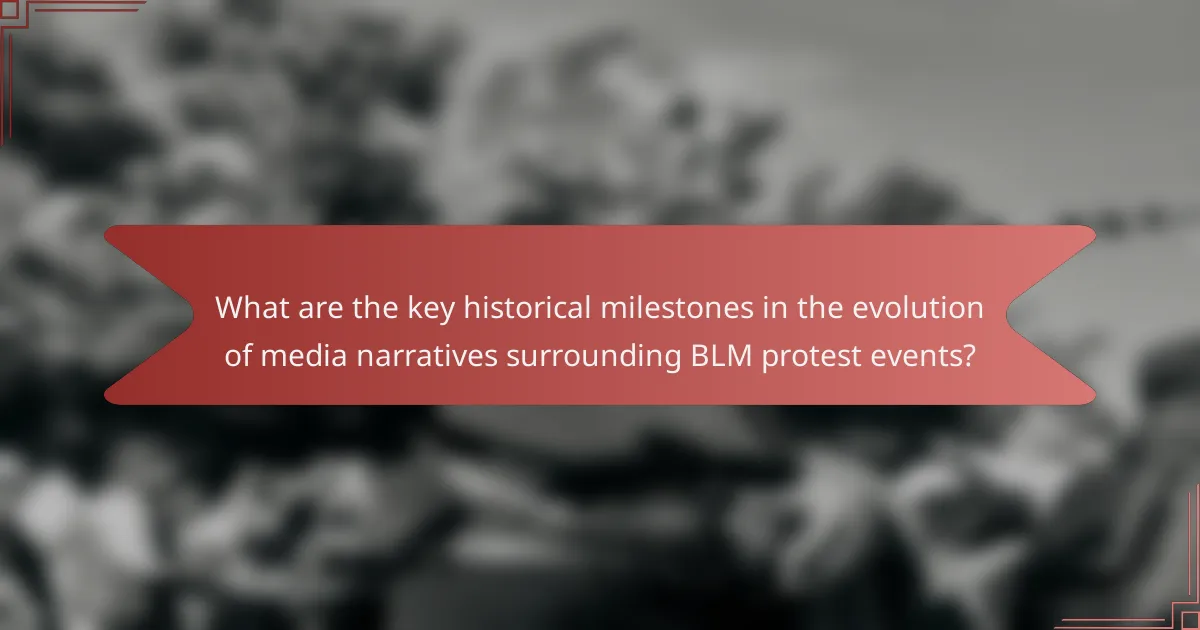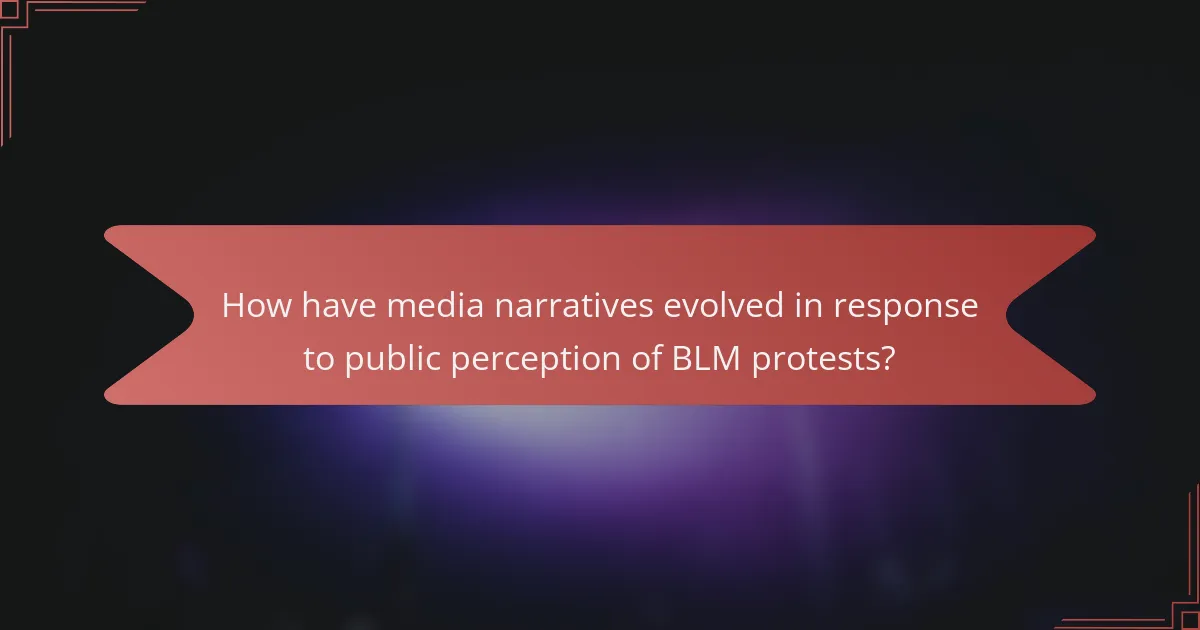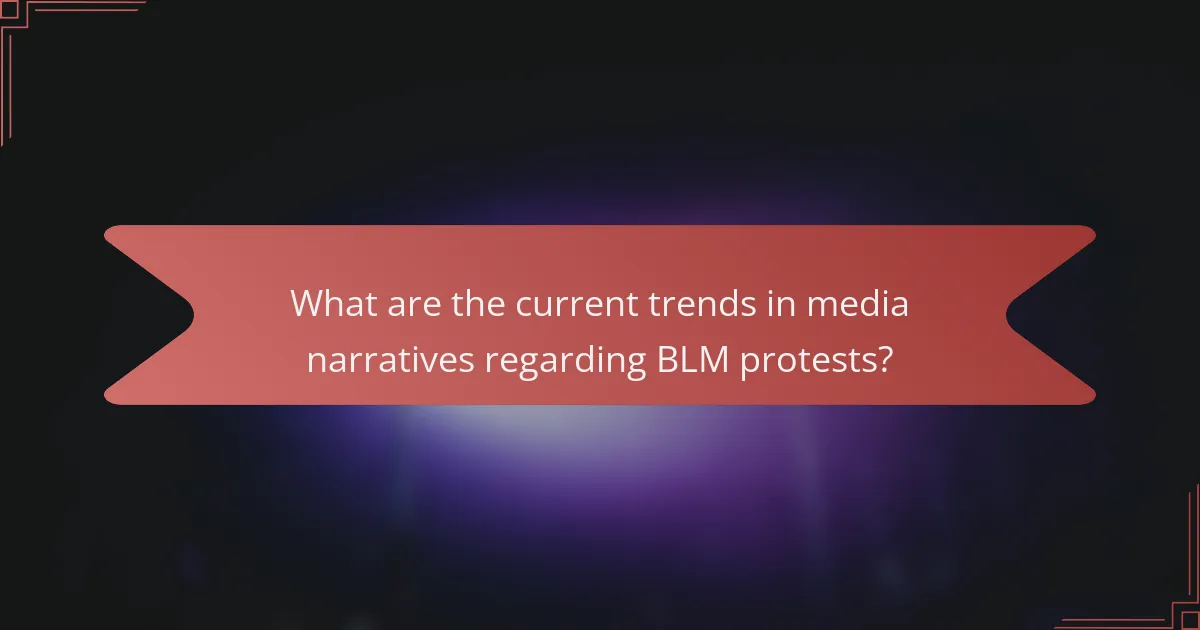
What are the key historical milestones in the evolution of media narratives surrounding BLM protest events?
The key historical milestones in the evolution of media narratives surrounding BLM protest events include the formation of the movement in 2013. This was marked by the hashtag #BlackLivesMatter following the acquittal of George Zimmerman in the shooting of Trayvon Martin. In 2014, the deaths of Michael Brown and Eric Garner sparked widespread protests, leading to increased media coverage. The media narrative began to shift towards highlighting systemic racism and police brutality. In 2020, the murder of George Floyd catalyzed global protests, amplifying the movement’s visibility. This event led to a significant shift in media narratives, focusing on racial justice and police reform. The coverage also began to include diverse voices and perspectives within the movement. Social media platforms played a crucial role in shaping and disseminating these narratives. The evolution of media narratives reflects changing societal attitudes towards race and justice in America.
How did media coverage of the BLM movement begin?
Media coverage of the BLM movement began in 2013. It was sparked by the acquittal of George Zimmerman in the shooting death of Trayvon Martin. The hashtag #BlackLivesMatter was first used on social media by Alicia Garza, Patrisse Cullors, and Opal Tometi. This online activism quickly gained traction, leading to widespread protests. Major news outlets began reporting on these events, highlighting issues of racial injustice. Coverage intensified after the deaths of Michael Brown and Eric Garner in 2014. These incidents prompted national conversations about police violence and systemic racism. Media narratives evolved to include personal stories and community perspectives.
What were the initial narratives presented by mainstream media?
Initial narratives presented by mainstream media focused on the protests’ violence and unrest. Coverage often highlighted clashes between protesters and law enforcement. Many outlets framed the events as riots rather than peaceful demonstrations. Reports frequently emphasized property damage and looting incidents. This portrayal created a perception of chaos and disorder. Some media narratives acknowledged systemic racism but often downplayed the broader context. The framing influenced public opinion and sparked debates about the protests’ legitimacy. Overall, initial narratives tended to sensationalize the unrest rather than address underlying issues.
How did social media influence early perceptions of BLM protests?
Social media significantly influenced early perceptions of BLM protests by providing a platform for real-time information sharing. It allowed activists to disseminate images and videos of police violence, which garnered widespread attention. Platforms like Twitter and Instagram amplified the visibility of protests, reaching global audiences quickly. This immediate access to content shaped public opinion and mobilized support. The hashtag #BlackLivesMatter became a rallying cry, uniting individuals across different regions. Studies indicate that social media engagement correlated with increased awareness of racial injustice. The viral nature of posts helped to challenge mainstream media narratives. Overall, social media played a crucial role in framing the discourse around BLM protests.
What shifts in media narratives occurred during significant BLM events?
Media narratives shifted significantly during Black Lives Matter (BLM) events. Initially, coverage often focused on protests and violence. As events progressed, narratives began to highlight systemic racism and police brutality. The portrayal of protesters evolved from rioters to activists advocating for justice. Mainstream media started to include diverse voices from the movement. Social media played a crucial role in amplifying these narratives. Coverage increasingly featured personal stories of victims and community impact. The framing of BLM shifted from a moment to a broader movement for racial equity. This evolution reflects changing public perceptions and demands for accountability.
How did the media portrayal change following the death of George Floyd?
Media portrayal shifted significantly after George Floyd’s death. Initially, coverage focused on the incident itself, highlighting police brutality. As protests erupted, the narrative expanded to emphasize systemic racism. Media outlets began to feature voices from the Black Lives Matter movement prominently. There was a noticeable increase in discussions about social justice and police reform. The portrayal also included a broader context of racial inequality in America. This change was reflected in the language used, which became more empathetic and urgent. Major news networks dedicated more airtime to protests and community responses. Overall, the media’s approach transformed to address deeper societal issues beyond the immediate event.
What role did alternative media play in shaping narratives during the protests?
Alternative media played a crucial role in shaping narratives during the protests. It provided platforms for marginalized voices often overlooked by mainstream media. This media type facilitated real-time reporting and grassroots storytelling. Social media platforms allowed for immediate dissemination of information and images. Alternative media challenged dominant narratives by highlighting systemic injustices. It also fostered community engagement and mobilization among activists. Research indicates that alternative media significantly influenced public perception during the Black Lives Matter movement. Studies show increased awareness and support for protest issues due to alternative media coverage.

How have media narratives evolved in response to public perception of BLM protests?
Media narratives surrounding BLM protests have evolved significantly in response to public perception. Initially, coverage often focused on violence and unrest, framing protests negatively. Over time, as public support for BLM grew, narratives shifted towards highlighting systemic racism and social justice.
This change was influenced by widespread protests following the deaths of George Floyd and Breonna Taylor in 2020. Major media outlets began to emphasize the voices of activists and the historical context of racial inequality.
Surveys indicated an increase in public support for BLM, with a 2020 Gallup poll showing 57% of Americans backing the movement. This shift prompted media to adopt a more nuanced approach, exploring the complexities of race relations in America.
Additionally, social media played a crucial role in shaping narratives. Platforms allowed marginalized voices to share their experiences, countering traditional media portrayals. The evolution of media narratives reflects a broader societal shift towards recognizing and addressing racial issues.
What impact did public reactions have on media reporting of BLM events?
Public reactions significantly influenced media reporting of BLM events. As protests gained momentum, media outlets adjusted their coverage to reflect public sentiment. Increased public engagement led to heightened scrutiny of police actions. This scrutiny prompted media to adopt a more critical stance on law enforcement. Social media played a crucial role in shaping narratives. Viral posts often dictated the stories that received attention. Journalistic practices evolved to prioritize diverse voices and perspectives. The demand for accountability from media sources increased as public awareness grew. Thus, public reactions directly shaped the focus and tone of media reporting on BLM events.
How did protests lead to changes in narrative framing by news outlets?
Protests significantly influenced changes in narrative framing by news outlets. Coverage shifted from isolated incidents to broader systemic issues. Initially, media often framed protests as riots or disturbances. Over time, narratives began to emphasize social justice and systemic racism. This change was driven by public demand for accountability and representation. News outlets faced pressure to reflect the voices of marginalized communities. As protests gained global attention, framing evolved to include historical context and calls for reform. Studies show that sustained activism led to increased awareness and changes in reporting practices.
What factors contributed to the polarization of media narratives around BLM?
Media narratives around Black Lives Matter (BLM) became polarized due to several key factors. First, differing political ideologies influenced media coverage. Outlets aligned with conservative views often emphasized law enforcement perspectives. In contrast, liberal outlets highlighted systemic racism and police brutality. Second, social media played a significant role in shaping public opinion. Platforms allowed for rapid dissemination of information, often leading to echo chambers. Third, sensationalism in reporting contributed to exaggerated narratives. This often resulted in focusing on extreme incidents rather than broader issues. Fourth, the timing of events, such as high-profile incidents of police violence, intensified media scrutiny. These incidents often sparked national protests, leading to increased media attention. Lastly, the involvement of various activist groups further complicated narratives. Different groups within the BLM movement have distinct goals and messages, leading to varied interpretations in media coverage.
How have different demographics responded to media narratives about BLM?
Different demographics have responded to media narratives about BLM in varied ways. African American communities often view BLM narratives as affirming their experiences with systemic racism. In contrast, some white demographics may perceive these narratives as divisive or threatening to their social status. Younger individuals, regardless of race, tend to support BLM narratives more than older generations. Research indicates that 67% of millennials support BLM, compared to 40% of baby boomers. Media framing also influences responses; positive portrayals of BLM can increase support among moderate individuals. Conversely, negative portrayals may reinforce opposition among conservative demographics. Overall, responses are shaped by personal experiences, age, and media consumption habits.
What variations exist in media consumption among different racial and ethnic groups?
Media consumption varies significantly among different racial and ethnic groups. African Americans tend to consume more digital media compared to other groups. According to the Pew Research Center, 78% of Black adults use social media platforms. Hispanic individuals often prefer bilingual content, reflecting their cultural background. White audiences generally engage more with traditional media like television. Asian Americans show a higher preference for streaming services. These differences stem from cultural preferences and accessibility. Understanding these variations is crucial for effective media strategies.
How do generational differences affect the interpretation of media narratives on BLM?
Generational differences significantly affect the interpretation of media narratives on BLM. Older generations may view BLM through the lens of historical civil rights movements. They often prioritize established narratives and traditional media sources. Younger generations, however, engage with social media and alternative narratives. They tend to emphasize intersectionality and systemic issues. Research shows that younger individuals are more likely to participate in online activism. This shift in engagement shapes how narratives are constructed and disseminated. For example, a 2020 Pew Research study found that 84% of younger adults support BLM compared to 57% of older adults. This disparity highlights differing values and priorities in interpreting media narratives.

What are the current trends in media narratives regarding BLM protests?
Current trends in media narratives regarding BLM protests focus on intersectionality and systemic racism. Media outlets increasingly highlight diverse voices within the movement. Coverage emphasizes the role of community organizations and grassroots activism. There is a growing trend to connect BLM protests with global movements for social justice. Additionally, media narratives often explore the impact of police violence on marginalized communities. Fact-checking and accountability in reporting have also gained prominence. Reports frequently analyze the influence of digital platforms in shaping public perception. These trends reflect an evolving understanding of race and inequality in society.
How are contemporary media narratives shaping the future of BLM activism?
Contemporary media narratives are significantly shaping the future of BLM activism by influencing public perception and mobilization efforts. Media coverage amplifies the voices of activists, highlighting issues of racial injustice and police violence. This increased visibility fosters community engagement and support for the movement. Social media platforms allow for real-time sharing of events and personal stories, creating a sense of urgency. Additionally, media narratives can frame the movement’s goals, impacting political discourse and policy changes. Studies show that positive media representation correlates with higher public support for BLM initiatives. The portrayal of protests in mainstream media affects how the movement is perceived globally, potentially inspiring similar activism in other regions.
What strategies are activists using to influence media narratives today?
Activists today employ various strategies to influence media narratives. They utilize social media platforms to amplify their messages. These platforms allow for real-time engagement and widespread reach. Activists create compelling visual content, such as videos and infographics, to capture attention. They also leverage hashtags to organize campaigns and unify voices around specific issues. Collaborating with journalists and media outlets helps ensure accurate representation of their narratives. Additionally, activists engage in grassroots organizing to mobilize community support and increase visibility. Research shows that social media campaigns can significantly impact public perception and media coverage. These strategies collectively shape the narratives surrounding social justice movements, including Black Lives Matter.
How do current narratives differ from those of earlier BLM events?
Current narratives around BLM events emphasize intersectionality and a broader social justice framework. Earlier narratives primarily focused on police violence against Black individuals. The shift reflects increased awareness of systemic racism and its various forms. Current discussions often include issues like economic inequality and environmental justice. Additionally, social media plays a crucial role in shaping today’s narratives. Platforms enable real-time sharing and diverse voices. This contrasts with earlier media coverage, which was often limited and less inclusive. Overall, the evolution highlights a more nuanced and comprehensive understanding of racial justice today.
What lessons can be learned from the evolution of media narratives in BLM protests?
The evolution of media narratives in BLM protests demonstrates the importance of framing and representation. Initially, media coverage often focused on violence and unrest. Over time, narratives shifted to highlight systemic racism and social justice. This evolution reflects broader societal changes in understanding racial issues. The role of social media has been crucial in amplifying diverse voices and perspectives. Grassroots movements have utilized platforms to counter mainstream narratives. The shift illustrates how public perception can be shaped by media framing. Accurate representation can foster empathy and understanding among audiences. Ultimately, media narratives can significantly influence public discourse and policy regarding racial equality.
What best practices can be adopted for responsible media coverage of social movements?
Responsible media coverage of social movements should prioritize accuracy, context, and representation. Media outlets must fact-check information before publication to avoid spreading misinformation. Providing historical context helps audiences understand the significance of the movement. Including diverse voices, especially those from marginalized communities, ensures balanced representation. Journalists should avoid sensationalism, focusing instead on the lived experiences of activists. Transparency about sources and methods builds trust with the audience. Ethical considerations, such as respecting the privacy of individuals involved, are crucial. Finally, ongoing engagement with the communities being reported on fosters accountability and deeper understanding.
How can activists effectively engage with media to shape narratives positively?
Activists can effectively engage with media to shape narratives positively by building strong relationships with journalists. Establishing trust helps ensure that activists’ perspectives are accurately represented. They should provide clear, factual information to support their messages. This includes using statistics and personal stories to humanize their causes. Activists can also leverage social media to amplify their voices and reach broader audiences. Engaging in timely media campaigns can capture public attention during significant events. Collaborating with media outlets to create informative content can further enhance narrative control. Research shows that positive media representation can influence public opinion and policy changes.
The main entity of the article is the evolution of media narratives in Black Lives Matter (BLM) protest events. The article outlines key historical milestones from the movement’s inception in 2013 to the present, highlighting significant events such as the deaths of Trayvon Martin, Michael Brown, Eric Garner, and George Floyd. It examines how media coverage has shifted from focusing on violence and unrest to emphasizing systemic racism, social justice, and diverse voices within the movement. The role of social media in shaping public perception and influencing narratives is also discussed, along with the impact of public reactions on media reporting and the current trends in media narratives surrounding BLM protests.